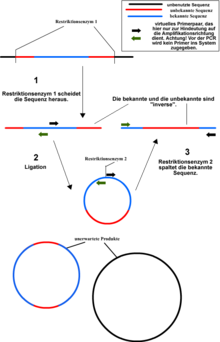Inverse polymerase chain reaction
As inverse polymerase chain reaction or shortly inverse PCR refers to a modification of PCR , with one unknown gene regions amplified can.
In reverse PCR, you need a relatively short but known sequence of DNA section. From this, two primers are produced which, in contrast to conventional PCR, are not directed towards one another, but whose direction is aimed at the unknown surrounding areas and between which there is a restriction site . The DNA is then isolated and digestion with a second restriction enzyme that does not cut in the previously known area, but outside. This is followed by a so-called annealing phase, in which the cut DNA fragments circularize, i.e. form a DNA ring. Then cut with the first restriction enzyme, which has its cleavage point in the known area between the primers. With a little luck you will get a previously unknown DNA region that lies between two mutually directed primers and that has a length suitable for a PCR. This can then be amplified using conventional PCR.
This technology is used e.g. B. used to examine places in which z. B. have integrated transposons or other foreign genes .
literature
- Ochman, H. et al. (1988): Genetic applications of an inverse polymerase chain reaction. In: Genetics. 120 (3): 621-623. PMID 2852134 PDF
- Ochman, H. et al. (1990): Inverse Polymerase Chain Reaction In: Biotechnology. 8 (8): 759-760. PMID 1366903 doi : 10.1038 / nbt0890-759
